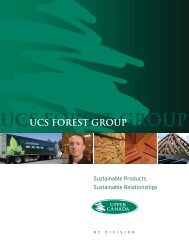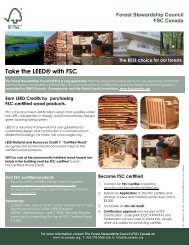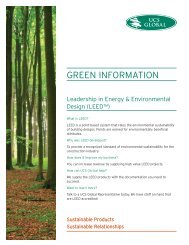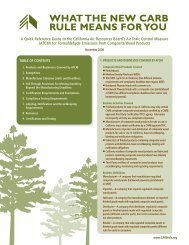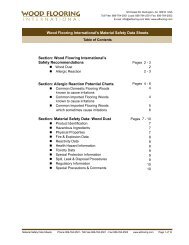Create successful ePaper yourself
Turn your PDF publications into a flip-book with our unique Google optimized e-Paper software.
modified wood available from Upper Canada / Sierra<br />
PERFORMANCE<br />
TESTING<br />
SUMMARY<br />
TRIED, TESTED AND PROVEN<br />
Accoya® is a product of<br />
Accsys Technologies
CONTENTS<br />
Choose from above
INTRODUCTION<br />
Accoya® wood is the result of over 80 years research<br />
and development. Combining the proven modification<br />
technique of acetylation with cutting-edge proprietary<br />
technology, this high performance wood is created for<br />
demanding outdoor applications; from windows to doors,<br />
decking to cladding, bridges to boats.<br />
Wood for Accoya® is sourced from sustainable forests and<br />
manufactured using a non-toxic process. However, its properties<br />
exceed those of the best tropical hardwoods and it can handle the<br />
most demanding jobs - even those that are presently only considered<br />
feasible with non-sustainable materials.<br />
Accoya® is a highly proven product with testing from many different<br />
perspectives on a worldwide basis. Many tests have been conducted<br />
in real-world conditions over many years. This summary shows some<br />
of these results. Full reports of these and similar tests are available<br />
upon request. Many are already posted in the downloads section on<br />
accoya.com.<br />
Introduction 01
LCA AND CARBON FOOTPRINT – CAMCO / TU DELFT<br />
The Carbon Footprint Reports from Camco UK<br />
and the Life Cycle Assessments from TU Delft,<br />
conducted using ISO 14040 compliant processes,<br />
both show that Accoya® wood outperforms<br />
competing building materials and is less harmful<br />
to the environment.<br />
Energy units required to manufacture<br />
1 ton of building material<br />
Independent research and testing has proven Accoya® wood’s<br />
superior environmental performance.<br />
Accoya® wood:<br />
• Uses less energy than cement, glass, steel and aluminium when<br />
utilised as a building material<br />
• Its manufacture emits less greenhouse gas than other major<br />
competing materials such as PVC, aluminium and unsustainably<br />
sourced tropical hardwoods when used in typical applications<br />
such as window frames<br />
• Outperforms aluminium, spruce and tropical hardwoods like<br />
red meranti on cost, maintenance and life span when used as a<br />
building material<br />
1<br />
TON<br />
Wood<br />
1<br />
TON<br />
1<br />
TON<br />
1<br />
TON<br />
1<br />
TON<br />
Cement Glass<br />
Steel Aluminium<br />
LCA and carbon footprint - Camco/TU Delft 02
LCA AND CARBON FOOTPRINT –<br />
CAMCO / TU DELFT<br />
The Carbon Footprint Reports from Camco<br />
UK and the Life Cycle Assessments from TU<br />
Delft, conducted using ISO 14040 compliant<br />
processes, both show that Accoya® wood<br />
outperforms competing building materials<br />
and is less harmful to the environment.<br />
A carbon footprint assessment was carried out on Accoya®<br />
wood using standard emission factors as referenced in the<br />
Camco study in line with the World Business Council for<br />
Sustainable Development and World Resources Institute’s<br />
(WBCSD/WRI) Greenhouse Gas (GHG) Reporting Protocol<br />
best practice guidelines (Bhatia and Ranganathan 2004).<br />
This assessment incorporates the six GHGs covered<br />
by the Kyoto Protocol: (carbon dioxide (CO2), methane<br />
(CH4), nitrous oxide (N2O), hydrofluorocarbons (HFCs),<br />
perfluorocarbons (PFCs) and sulphur hexafluoride (SF6).<br />
Each of these gases has a different impact on global<br />
warming potential, so they are translated into a single<br />
unit: carbon dioxide equivalent (CO2eq). This is the most<br />
widely accepted method of reporting all Kyoto GHGs.<br />
The graphs show that in terms of annual carbon footprint,<br />
Accoya® wood performs significantly better than<br />
metals (steel, aluminium), plastics (PVC), concrete and<br />
unsustainably sourced timber. In some cases, sustainably<br />
sourced wood has a negative carbon footprint due to<br />
the carbon sequestration effect modeled through the<br />
PAS (Publicly Available Specification) 2050 guidelines.<br />
However, when wood is unsustainably sourced, the annual<br />
emissions increase dramatically.<br />
The study we commissioned shows the comparative results<br />
of a carbon footprint assessment for the application of<br />
Accoya® wood in a pedestrian bridge and a window frame.<br />
Modified wood products based on fast growing timbers,<br />
such as Accoya®, have additional benefits which are not<br />
included in the carbon footprint assessment. Firstly, the<br />
supply of sustainably sourced, certified tropical hardwood<br />
is relatively small and secondly, the importation of<br />
uncertified, and in some instances illegal, hardwoods is<br />
still common practice.<br />
12.00<br />
10.00<br />
8.00<br />
6.00<br />
4.00<br />
2.00<br />
0.00<br />
500<br />
400<br />
300<br />
200<br />
100<br />
GHG emissions per window frame per year (kg C0 2 eq)<br />
Accoya® Tropical<br />
hardwood<br />
(sustainably<br />
sourced)<br />
PVC Aluminium Tropical<br />
hardwood<br />
(unsustainably<br />
sourced)<br />
Annual emissions per bridge (kg CO 2 /yr)<br />
0<br />
PVC<br />
-100<br />
Accoya®<br />
production mix<br />
Asobe<br />
(sustainably<br />
sourced)<br />
Asobe<br />
(unsustainably<br />
sourced)<br />
Concrete<br />
Steel<br />
LCA and carbon footprint - Camco/TU Delft<br />
03
SUPERIOR WHOLE LIFE<br />
COST FOR WINDOWS<br />
A study with a Dutch window producer/<br />
maintenance company shows that Accoya® is<br />
initially more expensive but has a lower total<br />
cost than PVC, aluminium, pine and hardwood<br />
windows over a reasonable ownership period.<br />
Cost (in ¤ 1,000)<br />
50<br />
40<br />
30<br />
20<br />
10<br />
Life cycle cost for window frames<br />
in a typical Dutch home<br />
B<br />
D<br />
E<br />
C<br />
A<br />
Accoya® wood:<br />
• Ensures lower maintenance costs<br />
• Ensures longer time between maintenance<br />
• Has extended durability and won’t need replacing<br />
for 50+ years<br />
0<br />
0 10 20 30 40 50<br />
Time (yrs)<br />
A<br />
B<br />
C<br />
Accoya® wood<br />
Meranti<br />
PVC<br />
D<br />
E<br />
Spruce - Hardwood<br />
Aluminium<br />
20<br />
Life maintenance cost<br />
Cost effectiveness<br />
(£ per 60+ years)<br />
15<br />
10<br />
5<br />
0<br />
Accoya® PVC Aluminium Pine<br />
Meranti<br />
Initial cost<br />
Superior Whole Life Cost For Windows<br />
04
DURABILITY COMPARISON – SCION<br />
Scion, formerly known as New Zealand<br />
Forest Research Institute Ltd, undertakes<br />
research and science and technology<br />
development in forestry, wood products,<br />
biomaterials and bioenergy. Scion tested<br />
the durability of Accoya® wood against<br />
other naturally durable and preservative<br />
treated timbers.<br />
The harsh test site runs exposed timbers in<br />
accelerated decay chambers and in exterior<br />
ground contact tests at the Whakarewarewa<br />
site. The tests have run for six years and<br />
show Accoya® performing better than teak,<br />
merbau, cypress, cedar and H3.2 (above ground,<br />
uncoated horizontal) and H4 (in ground contact)<br />
preservative (CCA) treated timbers, proving that<br />
Accoya® has the highest possible durability<br />
classification.<br />
Index of condition<br />
10<br />
8<br />
6<br />
4<br />
2<br />
0<br />
E<br />
C<br />
0 1 2 3 4 5 6<br />
Time (years)<br />
A<br />
B<br />
C<br />
Decay rates of fungus cellar stacklets<br />
Accoya® wood<br />
CCA H4<br />
CCA H3.2<br />
D<br />
E<br />
Merbau<br />
Radiata Pine<br />
A<br />
B<br />
D<br />
Index of condition<br />
10<br />
8<br />
6<br />
4<br />
2<br />
A<br />
B<br />
C<br />
Accoya® wood<br />
CCA H4<br />
CCA H3.2<br />
Decay rated field stakes<br />
0<br />
0 1 2 3 4 5 6<br />
Time (years)<br />
D<br />
E<br />
F<br />
Teak<br />
Macrocarpa<br />
Cedar<br />
B<br />
E<br />
A<br />
C<br />
F<br />
D<br />
Decay/insect damage rating system (ASTM D 1758)<br />
10 = No decay or insect damage<br />
T = Discolouration or trace of decay, not positively identified<br />
as decay<br />
9 = Minor decay, 0-3% of the cross section<br />
8 = Lightly established decay, 3-10% of the cross section<br />
7 = Well established decay, 10-30% of the cross section<br />
6 = Extensive and deep decay, 30-50% of the cross section<br />
4 = Deep and severe decay, more than 50% of the cross section<br />
0 = Failed<br />
Durability Comparison - SCION<br />
05
13-YEAR WINDOW<br />
L-JOINT TEST – BRE<br />
The BRE (Building Research Establishment) is an independent<br />
institute based in Watford, UK. In durability field testing to European<br />
Norm (EN) 330:1993 – which parallels America Wood-Preservers’<br />
Association (AWPA) E9 – simple mortice and tenon joints (L-joints) are<br />
assembled, coated and placed outside, with the coating over the joint<br />
deliberately broken to allow typical water ingress. This test represents<br />
a worst case scenario for joinery products and requires the coated<br />
wood to be exposed to normal environmental factors.<br />
In February 1998, L-joints were installed at the BRE Garston field exposure site<br />
(Watford, UK) facing the prevailing south westerly weather on an elevated test rig.<br />
The test remains in progress with inspections at regular intervals. The BRE reported:<br />
“In simulated accelerated joinery field trials that represent a worst case scenario<br />
joinery product by enabling moisture ingress into the joint pine, sapwood wood<br />
L-joints acetylated to a slightly lower modification level than Accoya®, after 13 years<br />
exposure in the UK are performing very well. The trial indicates that a permeable<br />
timber species that is acetylated through the cross section to a durability class 1 level<br />
(e.g. Accoya®), would have a grading lower than the reference preservative TnBTO –<br />
and thus Accoya® would exceed the biological reference value and would be deemed<br />
to provide sufficient protection for long life window joinery.”<br />
Non-acetylated<br />
wood showing<br />
rot and decay<br />
Non-acetylated wood<br />
showing major attack<br />
Non-acetylated<br />
wood showing<br />
severe rot and decay<br />
Accoya® wood<br />
showing no rot<br />
or decay<br />
Accoya® wood<br />
showing no rot<br />
or decay<br />
13-Year Window L-Joint Test - BRE<br />
06
60-YEAR SERVICE LIFE - BRE<br />
After running tests and reviewing external and independent data, the BRE concluded that Accoya®<br />
wood, provided best design practice is followed, has a service life expectancy of 60 years when used<br />
in exterior applications such as windows, doors, cladding and balconies. The BRE stated that Accoya®<br />
wood shows excellent durability and stability properties.<br />
“We consider that joinery, cladding and balconies prepared from Accoya® will show significantly improved coating performance<br />
properties. If the products are designed and built to the principles of best practice (to minimise moisture ingress and maximise<br />
water shedding), factory finished using quality coatings such as Sikkens or Teknos, installed by competent contractors and linked<br />
to a recognised best practice maintenance and care package, it will provide exterior wood products of outstanding durability and<br />
dimensional stability that would meet a 60-year service life requirement.”<br />
60-Year Service Life - BRE<br />
07
FORMOSAN TERMITE<br />
DURABILITY TEST - LSU<br />
LSU Formosan Termite Test Results<br />
Coptotermes formosanus, known as Formosan<br />
termites, are considered one of the world’s most<br />
aggressive termite. Louisiana State University<br />
(LSU) conducted a 99 day formosan termite<br />
‘choice’ test, using untreated radiata pine and<br />
Accoya® wood (2” x 4” lumber).<br />
Accoya® wood<br />
New Zealand Radiata<br />
(Leached)<br />
New Zealand Radiata<br />
(Un-Leached)<br />
0<br />
5<br />
10 15 20 25 30<br />
All four sides of the untreated radiata pine were attacked and<br />
left structurally compromised. In stark contrast, Accoya® wood<br />
only exhibited slight grazing.<br />
Chilean Radiata<br />
(Leached)<br />
% Weight Loss<br />
The results of standardised testing show that Accoya®<br />
wood was 22 times better than the untreated radiata (when<br />
measured by sample weight loss).<br />
Non Accoya® wood<br />
Chilean Radiata<br />
(Un-Leached)<br />
0<br />
5<br />
10 15 20 25 30<br />
% Weight Loss<br />
Southern Pine<br />
(Leached)<br />
Accoya® wood<br />
Southern Pine<br />
(Un-Leached)<br />
0<br />
5<br />
10 15 20 25 30<br />
% Weight Loss<br />
Untreated SYP Choice<br />
Accoya® wood<br />
Non Accoya® wood<br />
Formosan Termite Turability Test - LSU<br />
08
FIELD TEST –<br />
KAGOSHIMA<br />
TEST SITE, JAPAN<br />
The extreme two year field test conducted<br />
was primarily against two different types<br />
of termites in two locations of the field site<br />
located in Kagoshima, Japan. Coptotermes<br />
formosanus is present in a dry area and<br />
Reticulitermes speratus is active in a wet<br />
area of the site. Collectively the sites also<br />
have an assortment of rot fungi present<br />
including white and brown rots.<br />
Unacetylated stakes (both of sugi and radiata)<br />
performed poorly. Accoya® wood performed very well<br />
and was completely unscathed over the two years.<br />
Non Accoya®<br />
wood, wet test site<br />
Accoya® wood,<br />
wet test site<br />
Non Accoya®<br />
wood, dry test site<br />
Accoya® wood,<br />
dry test site<br />
Field Test - Kagoshima Test Site, Japan<br />
09
16-YEAR CANAL<br />
LINING TEST<br />
Accoya® wood’s high performance was proved with a 16-year<br />
project test from Waterschap Zuiderzeeland, near the junctions<br />
of the N301 and N305 Nijkerk – Zeewolde.<br />
In April 1995, acetylated and control wood was used to line a canal. After 16 years<br />
of exposure to fresh water, the acetylated wood showed no sign of rot, decay or<br />
fungal damage – highlighting its class 1 durability status.<br />
BS8417 indicates a 30 year service for durability class 1 in this fresh water scenario<br />
and Accoya® wood canal linings are showing real life positive results.<br />
These canal bank conditions are particularly punishing, especially at the waterline,<br />
since the wood is exposed to a combination of water, microbe rich soil and air.<br />
Non Accoya® wood<br />
Non Accoya® wood<br />
image 2<br />
Accoya® wood<br />
Accoya® wood<br />
16-Year Canal Lining Test<br />
10
STABILITY, DURABILITY &<br />
STRENGTH TESTS – TP<br />
Decay test results for Accoya® and Untreated Wood<br />
Trametes versicolour<br />
fungus<br />
Gloeophyllum trabeum<br />
fungus<br />
Timber Products Inspection (USA) undertook a<br />
number of thorough and independent tests to<br />
analyse Accoya® wood’s durability, stability and<br />
strength performance characteristics in accordance<br />
with the USA’s Window & Door Manufacturers<br />
Association (WDMA) requirements.<br />
Accoya® wood outperformed radiata pine in accelerated decay<br />
chambers highlighting its durability. The results showed that<br />
Accoya® wood had a very low weight loss percentage for both<br />
brown rot (Gloeophyllum trabeum) and white rot (Trametes<br />
versicolor) fungi against such types of decay.<br />
TP also showed that the average MOR and WML values of<br />
Accoya® are slightly higher than those of unmodified wood and<br />
the average MOE value of Accoya® is slightly lower than that of<br />
untreated specimens. Overall, the strength properties of Accoya®<br />
are essentially the same as those of the untreated control.<br />
The final test proved that Accoya® meets WDMA’s stringent rot<br />
resistance requirements, which means it’s an ideal choice for<br />
windows and doors.<br />
Weight loss (%)<br />
22 22<br />
20 20<br />
18 18<br />
16 16<br />
14 14<br />
12 12<br />
10 10<br />
8 8<br />
6 6<br />
4 4<br />
2 2<br />
0 0<br />
Accoya® Untreated<br />
Radiata Wood<br />
Accoya®<br />
Radiata<br />
Untreated<br />
Wood<br />
TP Conclusion<br />
MOR MOE WML<br />
Accoya® 1.23 0.90 1.14<br />
Unmodified 1.00 1.00 1.00<br />
*MOR<br />
*MOE<br />
*WML<br />
- Modulus of Rupture (ultimate bending strength)<br />
- Modulus of Elasticity (Youngs Elasticity)<br />
- Work to maximum Load<br />
Stability, Durability & Strength Tests - TP<br />
11
9.5-YEAR EXTERNAL<br />
COATINGS TEST – SHR<br />
Independent testing institute SHR Timber<br />
Research in The Netherlands conducted a<br />
comprehensive coatings test on Accoya® and<br />
untreated wood with opaque paints and stains.<br />
Accoya® wood outperformed all other timbers, with better coating<br />
performance and superior coating adhesion in both wet and dry<br />
conditions. The white opaque performed extremely well, requiring<br />
no maintenance after 9.5 years – which is an important benefit in<br />
the long-term life cost of the product and ensures that Accoya®<br />
has a superior whole life cost compared to competing materials.<br />
Unmodified<br />
Accoya® wood<br />
Unmodified<br />
Accoya® wood<br />
9.5 Year - External Coatings Test - SHR<br />
12
42-MONTH EXTERNAL<br />
COATINGS TEST – TRADA<br />
Leading timber research institute, TRADA,<br />
was commissioned by Accsys Technologies to<br />
provide an update on a series of exposure trials.<br />
surface checking and board distortion; whilst Siberian larch<br />
was found to have extensive surface checking and burst resin<br />
pockets.<br />
Pine<br />
Accoya®<br />
The ongoing trials using the same coating began in February<br />
2007 in Buckinghamshire, England and tested Accoya®<br />
cladding board’s resistance to natural weathering and splitting<br />
in comparison to pine and Siberian larch.<br />
After 42-months, Accoya® wood was found to outperform the<br />
competing cladding boards in a number of ways – showing<br />
excellent coating performance.<br />
Pine cladding boards showed severe levels of fissuring, resin<br />
exudation, end fissuring, paint peeling over fissures, shelling,<br />
Accoya® wood, however, had a flat cladding surface with<br />
no grain raising, virtually no shelling, cracking, checking or<br />
fissuring. External dirt was easily cleaned off revealing a<br />
sound clean surface with no rot, decay or coating issues. This<br />
harsh test proves that Accoya® wood has superior coating<br />
performance compared to many competing materials.<br />
Accoya® wood cladding<br />
Pine cladding<br />
Siberian larch cladding<br />
42 - Month External Coatings Test - Trada<br />
13
DIMENSIONAL<br />
STABILITY TEST –<br />
TRADA<br />
Leading timber research institute, TRADA,<br />
tested the stability of Accoya® wood<br />
against other widely used cladding materials<br />
by exposing boards to a high humidity<br />
environment and letting them acclimate.<br />
TRADA found that Accoya® wood had exceptional<br />
stability and stated that Accoya® used for cladding<br />
boards could increase from standard 150mm wide<br />
profiles to 200mm when used externally.<br />
Distortion (mm)<br />
6<br />
5<br />
4<br />
3<br />
2<br />
1<br />
A<br />
B<br />
C<br />
Accoya® wood<br />
European larch<br />
Western red cedar<br />
TRADA stability test graph<br />
0<br />
0 50 100 150<br />
Time (hours)<br />
D<br />
E<br />
F<br />
D<br />
E<br />
F<br />
B<br />
Siberian larch<br />
Pine<br />
Thermowood<br />
C<br />
A<br />
Comparative cupping of cladding profiles<br />
Siberian larch<br />
Western red cedar<br />
This increased width specification board shows Accoya®<br />
wood’s design flexibility and superior performance<br />
when compared to western red cedar, larch and pine.<br />
Accoya® wood<br />
Dimensional Stability Test - TRADA<br />
14
DIMENSIONAL STABILITY<br />
TEST – SHR<br />
8<br />
7<br />
Tangential shrinkage* (%)<br />
6<br />
Leading Dutch timber research institute, SHR, undertook a<br />
series of robust tests to evaluate the dimensional stability<br />
of Accoya® wood.<br />
5<br />
4<br />
3<br />
2<br />
Accoya® wood outperformed a wide range of competing timber products such<br />
as ipe, teak, selangan, Japanese cypress, western red cedar, dark red meranti,<br />
radiata pine and Japanese cedar. This test proves Accoya® wood is ideal for<br />
exterior applications like windows, doors, cladding, decking and large structures.<br />
1<br />
0<br />
Accoya®<br />
wood<br />
Teak Iroko Sapele<br />
Scots<br />
pine<br />
*typical tangential shrinkage from fully soaked to oven dry - the most extreme<br />
laboratory test<br />
Test on teak, iroko, sapele and scots pine have been extracted from published data:<br />
Physical and related properties of 145 Timbers<br />
Jan F. Rijsdijk and Peter B. Laming<br />
Kluwer Academic Publishers<br />
ISBN 0-7923-2875-2<br />
Volume shrinkage (%)<br />
12<br />
9<br />
6<br />
3<br />
0<br />
Accoya®<br />
wood<br />
Teak<br />
Western<br />
red cedar<br />
Japanese<br />
cypress<br />
Japanese<br />
cedar<br />
Radiata<br />
pine<br />
Dimensional Stability Test SHR<br />
15
IMPROVED THERMAL<br />
PERFORMANCE<br />
Buildcheck, a BFRC (British Fenestration<br />
Rating Council) approved assessment body,<br />
has proven that a window’s U Value can be<br />
significantly improved merely by changing<br />
the frame substrate from traditional<br />
hardwood or softwood to Accoya® wood.<br />
This simple change can also improve the<br />
window’s overall energy rating by one band,<br />
for example a C to a B. Testing to Dutch and<br />
German national standards by IFT Rosenheim<br />
provides a declared thermal value for Accoya®<br />
of y 0.120 W/(m/k). Testing to UK and Nordic<br />
national standards determines the thermal<br />
value is y 0.113 W/(m/k).<br />
y<br />
Average [W/(m/K)]<br />
0.20<br />
0.15<br />
0.10<br />
0.05<br />
0<br />
Accoya®<br />
wood<br />
Comparison with other species<br />
Softwood<br />
Hardwood<br />
Accoya® wood:<br />
• 17% more thermally efficient than typical softwoods<br />
• 40% more thermally efficient than typical hardwoods<br />
• Windows have achieved A rated status under the BFRC<br />
energy rating system<br />
Improved Thermal Performance<br />
16
HARDNESS & WEAR<br />
TEST – TRADA<br />
5<br />
4<br />
TRADA mean hardness<br />
Independent testing from leading timber<br />
research institute, TRADA, proved that<br />
Accoya® wood can withstand harsh, abrasive<br />
environments.<br />
Load (kN)<br />
3<br />
2<br />
1<br />
0<br />
Accoya®<br />
wood<br />
Siberian larch<br />
European<br />
larch<br />
Western<br />
red cedar<br />
Western red cedar<br />
TRADA’s testing showed that hardening that occurs as a<br />
result of the Accoya® process results in greater resistance<br />
to indentation than western red cedar and two types of<br />
larch. This is particularly useful when making specification<br />
choices for cladding and ground floor exterior products.<br />
Separate scuffing and mechanical abrasion tests carried<br />
out by TRADA show that Accoya® wood is just as good,<br />
if not better than the two types of larch, and significantly<br />
better than western red cedar.<br />
Weight loss (g)<br />
3<br />
2.5<br />
2<br />
1.5<br />
1<br />
0.5<br />
Taber abrasion test<br />
C<br />
D<br />
B<br />
A<br />
Siberian larch<br />
0<br />
0 500 1000 1500 2000<br />
Revolutions (rpm)<br />
A<br />
B<br />
Accoya® wood<br />
Western red cedar<br />
C<br />
D<br />
European larch<br />
Siberian larch<br />
Accoya® wood<br />
Hardness & Wear Test – TRADA<br />
17
FLAME SPREAD TEST AND SMOKE<br />
DEVELOPED TEST - SWRI<br />
In March 2009, Southwest Research Institute<br />
undertook Flame Spread Tests and Smoke<br />
Developed Tests in accordance with the standard<br />
test method for surface burning characteristics<br />
of building materials NFPA 255 (ANSI, UL 723 &<br />
UBC 8-1).<br />
The conclusion of the Flame Spread Test results is that Accoya®<br />
wood can be classified within the range of standard timber<br />
species and achieves Class C in this US rating system.<br />
Wood / Species<br />
Lodgepole pine 93<br />
Accoya® 95<br />
Oak 100<br />
Sitka spruce 100<br />
Maple 104<br />
Birch 105<br />
Cottonwood 115<br />
Flame Spread Index*<br />
* data source - USDA - United States Dept of<br />
Agriculture Wood Handbook. Lower numbers<br />
equal a lower flame spread.<br />
Flame Spread Classification<br />
Flame Spread Rating or Index<br />
Wood / Species<br />
Smoke Developed Index*<br />
Class I (or A) 0 - 25<br />
Class II (or B) 26 - 75<br />
Class III (or C) 76 - 200<br />
Yellow cedar 90<br />
Oak 100<br />
Eastern white pine 122<br />
Accoya® 155<br />
Lodgepole pine 210<br />
Western red cedar 213<br />
* data source - USDA - United States Dept of<br />
Agriculture Wood Handbook. Lower numbers<br />
equal less smoke.<br />
Flame Spread Test And Smoke Developed Test - SWRI<br />
18
www.ucfp.com<br />
www.sierrafp.com<br />
For more information and to download the latest test reports on<br />
Accoya®’s outstanding performance, tested by leading independent<br />
institutes, then visit the download section at www.accoya.com<br />
Toronto<br />
7088 Financial Drive<br />
Mississauga, Ontario<br />
Canada L5N 7H5<br />
Toll Free: 1 866 265 0624<br />
Tel: 905 814 8000<br />
Email: sales_toronto@ucfp.com<br />
Kelowna<br />
#108-2250 Acland Road<br />
Kelowna, British Columbia<br />
Canada V1X 6N6<br />
Toll Free: 1 866 265 0624<br />
Tel: 250 765 2018<br />
Email: sales_kelowna@ucfp.com<br />
Chicago<br />
1801 Hawthorne Lane<br />
West Chicago, Illinois<br />
USA 60185<br />
Toll Free: 1 800 646 7564<br />
Tel: 630 231 0450<br />
Email: sales_chicago@sierrafp.com<br />
Salt Lake City<br />
5825 Harold Gatty Drive<br />
Salt Lake City, Utah<br />
USA 84116<br />
Toll Free: 1 800 678 2801<br />
Tel: 801 972 3377<br />
Email: sales_saltlakecity@sierrafp.com<br />
Portland<br />
560 21st Street SE<br />
Salem, Oregon<br />
USA 97301<br />
Toll Free: 1 877 722 0070<br />
Tel: 253 852 0070<br />
Email: sales_portland@sierrafp.com<br />
Edmonton<br />
Toll Free: 1 866 265 0624<br />
Tel: 780 863 3316<br />
Email: sales_edmonton@ucfp.com<br />
Calgary<br />
4715 52nd Avenue S.E.<br />
Calgary, Alberta<br />
Canada T2C 4N7<br />
Toll Free: 1 866 265 0624<br />
Tel: 403 569 8829<br />
Email: sales_calgary@ucfp.com<br />
Vancouver<br />
5768 Trapp Avenue<br />
Burnaby, British Columbia<br />
Canada V3N 5G4<br />
Toll Free: 1 866 265 0624<br />
Tel: 604 522 3334<br />
Email: sales_vancouver@ucfp.com<br />
Denver<br />
14704 E. 33rd Place, Unit A<br />
Aurora, Colorado<br />
USA 80011<br />
Toll Free: 1 877 972 9112<br />
Tel: 303 539 5894<br />
Email: sales_denver@sierrafp.com<br />
Seattle<br />
25612 74th Avenue S.<br />
Kent, Washington<br />
USA 98032<br />
Toll Free: 1 877 722 0070<br />
Tel: 253 852 0070<br />
Email: sales_seattle@sierrafp.com<br />
Los Angeles<br />
13575 Benson Avenue<br />
Chino, CA<br />
USA 91710<br />
Toll Free: 1 800 548 3975<br />
Tel: 909 591 9442<br />
Email: sales_losangeles@sierrafp.com<br />
www.accoya.com<br />
ACCOYA® and the trimarque device are registered<br />
trademarks owned by Titan Wood Limited, trading as<br />
Accsys Technologies, a wholly owned subsidiary of Accsys<br />
Technologies Plc, and may not be used or reproduced<br />
without written permission.<br />
Accsys Technologies Plc is listed on the London Stock<br />
Exchange AIM market and Euronext Amsterdam by NYSE<br />
Euronext under the symbol AXS.<br />
ACCOYA® wood should always be installed and used in<br />
accordance with the written instructions and guidelines<br />
of Accsys Technologies and/or its agents (available upon<br />
request). Accsys Technologies accepts no liability for any<br />
defect, damage or loss that may occur where such written<br />
instructions and guidelines are not adhered to.<br />
To the best of the knowledge and belief of Accsys<br />
Technologies the information contained in this document is<br />
in accordance with the facts and is provided on the basis<br />
that Accsys Technologies and/or any of its affiliates, officers,<br />
employees or advisers are not liable for any loss or damage<br />
whatsoever in respect of the accuracy or completeness of<br />
such information or the result of having acted upon it.<br />
Accsys Technologies<br />
Royal Albert House<br />
Sheet Street<br />
Windsor SL4 1BE<br />
United Kingdom<br />
Brochure version TW-EUR/GB-Feb 12.<br />
© Accsys Technologies 2012<br />
UK Patent No.2 456 915<br />
South Africa Patent No. 2010/05240



